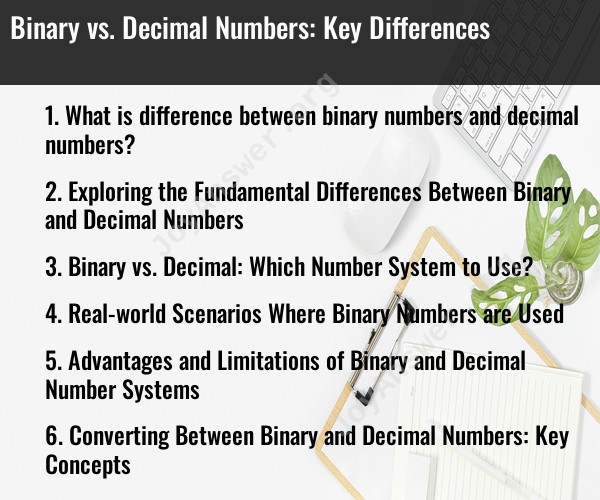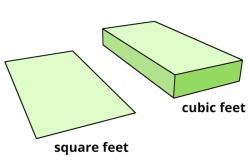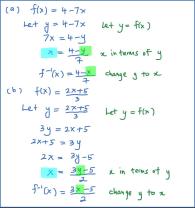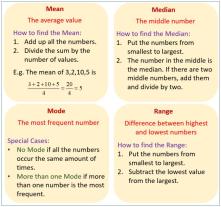What is difference between binary numbers and decimal numbers?
Binary and decimal numbers are two different numerical systems used to represent and express values. Here are the key differences between binary and decimal numbers:
Base:
- Decimal numbers are based on the decimal system, which has a base of 10. In the decimal system, each digit represents a power of 10.
- Binary numbers are based on the binary system, which has a base of 2. In the binary system, each digit represents a power of 2.
Number of Digits:
- In the decimal system, there are ten digits: 0, 1, 2, 3, 4, 5, 6, 7, 8, and 9.
- In the binary system, there are only two digits: 0 and 1.
Positional Notation:
- Both binary and decimal systems use positional notation. In positional notation, the value of a digit depends on its position within the number. The rightmost digit represents the units, the next to the left represents multiples of the base, and so on.
Counting:
- Decimal numbers count in powers of 10. Each position represents a power of 10 (e.g., 10, 100, 1000, etc.).
- Binary numbers count in powers of 2. Each position represents a power of 2 (e.g., 2, 4, 8, etc.).
Representation:
- In the decimal system, a number is represented using the digits 0 through 9, and each digit contributes a value based on powers of 10.
- In the binary system, a number is represented using only the digits 0 and 1, with each digit contributing a value based on powers of 2.
Size and Length:
- Binary numbers are typically longer than their decimal counterparts for the same value. This is because binary numbers require more digits to represent the same quantity as a decimal number.
Conversion:
- Decimal to binary conversion involves dividing the decimal number by 2 repeatedly and recording the remainders to obtain the binary representation.
- Binary to decimal conversion is done by adding up the powers of 2 represented by the binary digits.
Human Use:
- Decimal numbers are the primary numerical system used by humans for everyday calculations, counting, and arithmetic.
- Binary numbers are mainly used in computer systems and digital electronics, as they are the fundamental language of computers and represent the presence or absence of electrical signals.
Examples:
- Decimal: 123 represents "one hundred twenty-three."
- Binary: 111 represents "seven" in decimal, as it's 2^2 + 2^1 + 2^0.
Overall, the choice between binary and decimal depends on the context and the specific requirements of a task. Decimal numbers are the default choice for most human calculations, while binary is fundamental to the operation of computers and digital devices.
Exploring the Fundamental Differences Between Binary and Decimal Numbers
Binary and decimal are two fundamental number systems used to represent numerical values. While they share the same purpose, they differ significantly in their underlying structure and representation.
Binary is a base-2 number system, meaning it utilizes only two digits, 0 and 1, to represent any numerical value. This system is primarily used by computers and digital devices for data storage and processing.
Decimal is a base-10 number system, employing ten digits, 0 to 9, to represent numbers. This system is the most commonly used in everyday life for calculations, measurements, and various applications.
The fundamental difference between binary and decimal lies in their place value system. In decimal, each digit's value is determined by its position relative to the decimal point. For instance, in the number 123, the digit '1' represents 100, '2' represents 20, and '3' represents 3.
In binary, however, each digit's value is determined by its position relative to the binary point, with each position representing a power of 2. For example, in the number 1011, the digit '1' on the left represents 8, the second '1' represents 4, the '0' represents 2, and the last '1' represents 1.
Binary vs. Decimal: Which Number System to Use?
The choice between binary and decimal depends on the specific context and application.
Binary is the preferred number system for computers and digital devices due to its simplicity and efficiency in representing and processing electronic signals. Binary's simplicity allows for faster data manipulation and storage within computers.
Decimal, on the other hand, is more suitable for human comprehension and everyday calculations. Its familiarity and ease of use make it the preferred system for most mathematical operations and daily activities.
Real-world Scenarios Where Binary Numbers are Used
Binary numbers are prevalent in various real-world applications, particularly those involving computers and digital technology. Here are some examples:
Computer Memory: Binary numbers are used to store data in computer memory, including programs, images, and documents.
Data Communication: Binary numbers are used to transmit data over networks, such as the internet, ensuring accurate and reliable communication.
Digital Logic: Binary numbers form the basis of digital logic circuits, which are essential components of computers and electronic devices.
Image Processing: Binary numbers are used to represent and manipulate digital images, enabling various image processing techniques.
Cryptography: Binary numbers are employed in cryptographic algorithms to secure data and protect information.
Advantages and Limitations of Binary and Decimal Number Systems
Binary
Advantages:
Efficient for computer storage and processing
Simple and compact representation
Well-suited for digital logic circuits
Limitations:
Not as intuitive or easily understood by humans
Requires conversion to decimal for many applications
Decimal
Advantages:
Familiar and easy to understand for humans
Convenient for everyday calculations and measurements
Widely used in various fields, including science, engineering, and finance
Limitations:
Less efficient for computer storage and processing
Requires more digits to represent large numbers
Converting Between Binary and Decimal Numbers: Key Concepts
Converting between binary and decimal numbers involves understanding the place value system of each system.
Converting Binary to Decimal:
Identify the binary number and its base (2).
Assign each digit its corresponding place value (2^0, 2^1, 2^2, ...).
Multiply each digit by its respective place value.
Add up the products of all digits to obtain the decimal equivalent.
Converting Decimal to Binary:
Identify the decimal number and its base (10).
Repeatedly divide the decimal number by 2, keeping track of the remainders (0 or 1).
The remainders, read from bottom to top, represent the binary equivalent.













